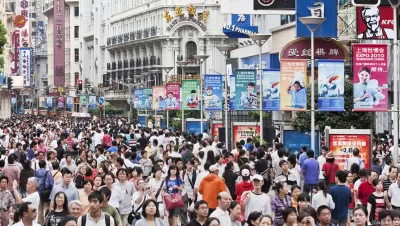China's one-child policy, which compelled couples to seek abortions or undergo sterilization procedures, ended in October 2015. Yet the country's birth rate hasn't increased, and Communist Party officials are concerned about economic growth.

"Almost three years after easing its “one child” policy and allowing couples to have two children, the government has begun to acknowledge that its efforts to raise the country’s birthrate are faltering because parents are deciding against having more children," report Steven Lee Myers and Olivia Mitchell Ryan for The New York Times.
Officials are now scrambling to devise ways to stimulate a baby boom, worried that a looming demographic crisis could imperil economic growth — and undercut the ruling Communist Party and its leader, Xi Jinping.
Experts say the government has little choice but to encourage more births. China — the world’s most populous nation with more than 1.4 billion people — is aging quickly, with a smaller work force left to support a growing elderly population that is living longer. Some provinces have already reported difficulties meeting pension payments.
It would seem that an obvious means to increase the birth rate would be to end the two-child policy or "family planning" as the provincial government in Shaanxi in central China called for last month. A plan to do that is under consideration, but it is a sensitive issue because it would be an admission of failure of a program that touched everyone.
So the goal has been to encourage second births, which Leta Hong Fincher in her February 20 op-ed in The Times describes as "the government embarking on another grand experiment in population engineering: This time it was urging women — though only the right sort — to reproduce for China." Party officials are targeting women who are younger than 30 to have children for "scientific reasons." Fincher goes on to describe other ways that the state's reproductive policy shows "eugenic undertones."
Myers and Ryan add that "[s]ome provinces are already tightening access to abortion or making it more difficult to get divorced."
So far, the results have not been promising. Demographic data released in January "showed that the country’s birthrate fell by 3.5 percent in 2017 compared with the previous year," added Fincher.
Population expected to crash
"China’s population inevitably will start to crash in 2040," wrote Sissi Cao for the Observer in "3 of the World’s 5 Largest Economies Are Facing a Population Crisis" on June 6.
As of 2016, an average woman in Japan had just 1.4 babies; this number was 1.5 in Germany and 1.6 in China. All were well below the “replacement fertility rate [of 2.1 for developed nations],” the minimum birth rate required for a country’s dying population to be sufficiently replaced by newborns.
"It is unclear whether lifting the two-child limit now will make much of a difference," add Myers and Ryan.
As in many countries, educated women in Chinese cities are postponing childbirth as they pursue careers. Young couples are also struggling with economic pressures, including rising housing and education costs.
The article describes other measures to boost fertility rates, not just by the government but from private companies as well, in order to increase the labor supply in the future.
Additional posts on China's population policy can be found under the tag, "One-Child Policy."
FULL STORY: Burying ‘One Child’ Limits, China Pushes Women to Have More Babies

Alabama: Trump Terminates Settlements for Black Communities Harmed By Raw Sewage
Trump deemed the landmark civil rights agreement “illegal DEI and environmental justice policy.”

Planetizen Federal Action Tracker
A weekly monitor of how Trump’s orders and actions are impacting planners and planning in America.

The 120 Year Old Tiny Home Villages That Sheltered San Francisco’s Earthquake Refugees
More than a century ago, San Francisco mobilized to house thousands of residents displaced by the 1906 earthquake. Could their strategy offer a model for the present?

Ken Jennings Launches Transit Web Series
The Jeopardy champ wants you to ride public transit.

BLM To Rescind Public Lands Rule
The change will downgrade conservation, once again putting federal land at risk for mining and other extractive uses.

Indy Neighborhood Group Builds Temporary Multi-Use Path
Community members, aided in part by funding from the city, repurposed a vehicle lane to create a protected bike and pedestrian path for the summer season.
Urban Design for Planners 1: Software Tools
This six-course series explores essential urban design concepts using open source software and equips planners with the tools they need to participate fully in the urban design process.
Planning for Universal Design
Learn the tools for implementing Universal Design in planning regulations.
Clanton & Associates, Inc.
Jessamine County Fiscal Court
Institute for Housing and Urban Development Studies (IHS)
City of Grandview
Harvard GSD Executive Education
Toledo-Lucas County Plan Commissions
Salt Lake City
NYU Wagner Graduate School of Public Service


























